HISTORY OF OBLIQUE ILLUMINATORS
Authors: Jurriaan de Groot and Barry Sobel
Editor: Joe Zeligs
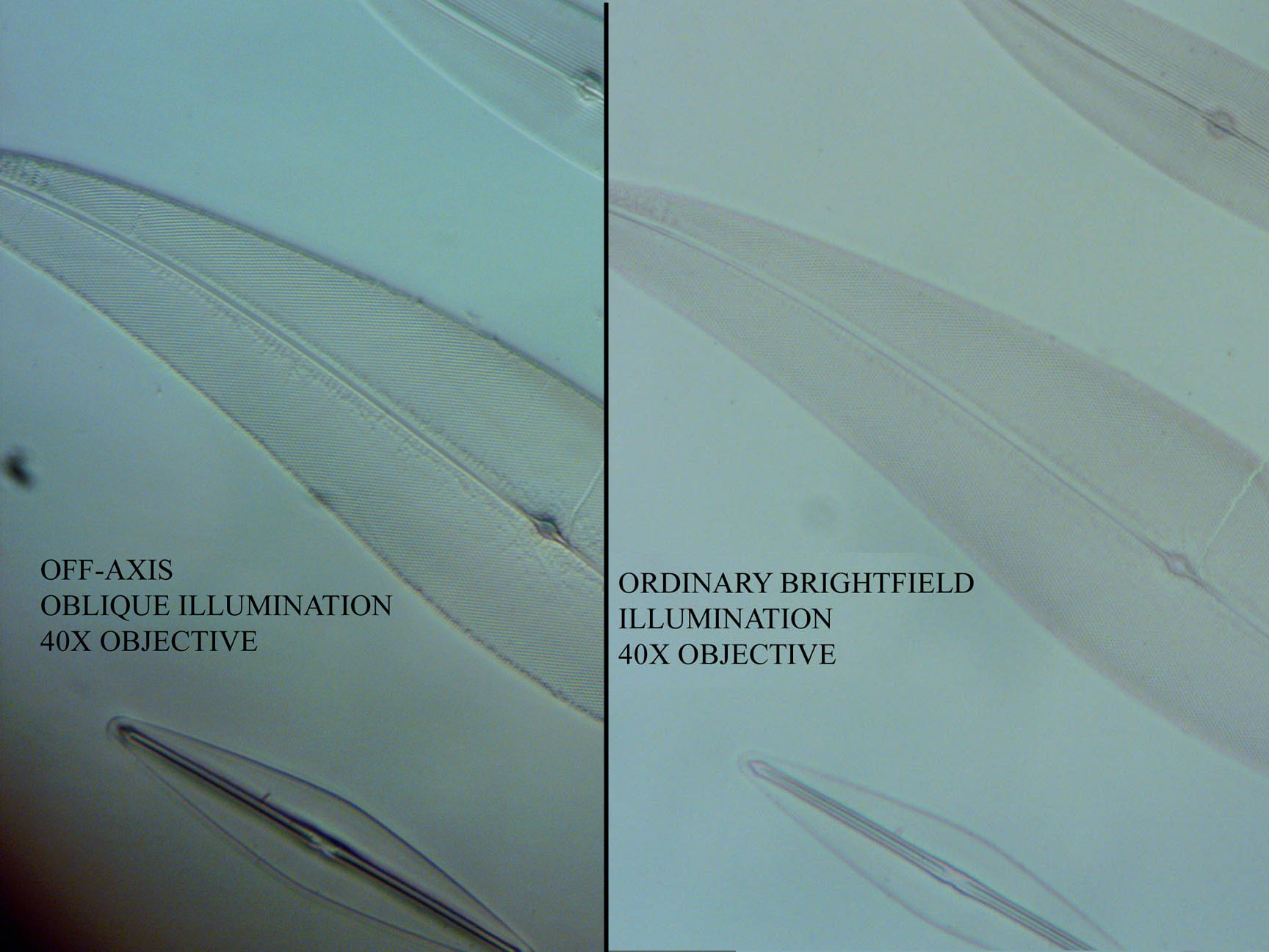
INTRODUCTION:
One of the problems that arose early on in microscopy was detecting things that had little intrinsic contrast, either due to size, being too close together, being very small, or because the refractive index of their internal structures had refractive indices too close to each other. The techniques of oblique illumination and dark ground illumination began early in the history of the microscope but specific equipment to fascilitate these arose later. Oblique illumination is particularly good for visualizing periodic structures that are very close together within e.g. a diatom.
Oblique illumination is one way of increasing resolution. The finest details of the specimen are obtained from diffracted beams that are apart from the axial light. So, when the objective is focused on lines which are close together, when you take the eye piece out, and examine the back image of the objective (e.g. with a phase telescope or Bertrand lens), their diffracted images will be further apart, whereas when the lines have a greater distance from each other in the specimen, their diffracted images at the back of the objective will be seen to be closer together. In accordance to Abbe’s theory of diffraction, at least two orders of diffraction are needed to recover the details of the object (at a minimum, they could be the axial image, and one more peripheral diffracted image in the back of the objective). When these two diffracted images are too far apart for them to show up simultaneously in the back image of the objective, the object will NOT be resolved, and what are actually two separate lines in the object e.g. a diatom, will be seen as one. Now, what oblique illumination does, is in ONE direction to shift one of these peripherally diffracted images back into the back image of the objective, so now there are two (the axial one, now shifted out of center, and the first order diffracted image in the periphery, fulfilling the minimum requirement of resolution, so that the two are seen as two separate lines or points. The main advantage of oblique lighting is therefore that the resolution is increased by effectively doubling the angular aperture. It follows, that the greater the angle of obliquity, the greater the resolution, up to the point where is gets close to being parallel to the surface. This is the basis for oblique illumination. One way to create oblique illumination was with the swinging substage(see below), but as the angular aperture of condensers increased, the use of a swinging substage to increase the angle of illumination was no longer needed.
Dark ground illumination, on the other hand, is best for visualizing very small objects like bacteria, spirochetes or tiny features on the outside of a an organism like a flagella. Dark ground illuminators are reviewed on another web page on this site.
One variation of this is central oblique illumination
.
When the N.A. of the objective is greater than that of the condenser (or the central stop does not fully render the field black) you get COL = Central Oblique Illumination, an under appreciated technique, which, depending on the object, sometimes gives as good, or better results than Phase Contrast.
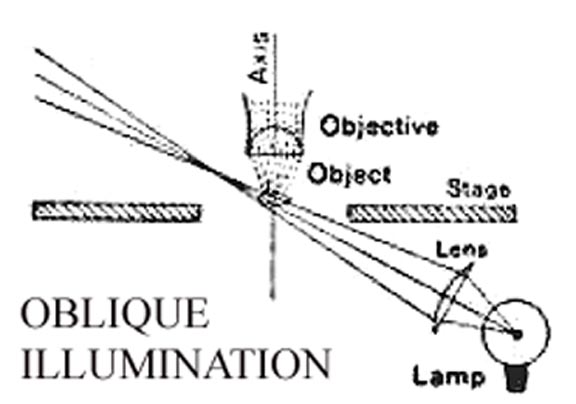 Among the first to report on a substage method of oblique illumination was the Rev. J. B. Reade of Cambridge as reported in the appendix of the book Micrographia authored by Pritchard and Goring in 1837. This is next mentioned in John Quekett's Practical Treatise on the Use of the Microscope of 1848, pages 178-9. As time went on, various devices were developed to improve the ease, precision, and degree of oblique lighting. Three ways to improve oblique lighting were commonly used in the 3rd quarter of the 19th century, and later. These included the use of the Amici Lenticular Prism Illuminator, the Swinging Substage, the use of under-condenser Oblique Inserts (
Among the first to report on a substage method of oblique illumination was the Rev. J. B. Reade of Cambridge as reported in the appendix of the book Micrographia authored by Pritchard and Goring in 1837. This is next mentioned in John Quekett's Practical Treatise on the Use of the Microscope of 1848, pages 178-9. As time went on, various devices were developed to improve the ease, precision, and degree of oblique lighting. Three ways to improve oblique lighting were commonly used in the 3rd quarter of the 19th century, and later. These included the use of the Amici Lenticular Prism Illuminator, the Swinging Substage, the use of under-condenser Oblique Inserts (Stops
),and the dedicated Oblique Illuminator
THE AMICI AND ABRAHAM OBLIQUE ILLUMINATORS:
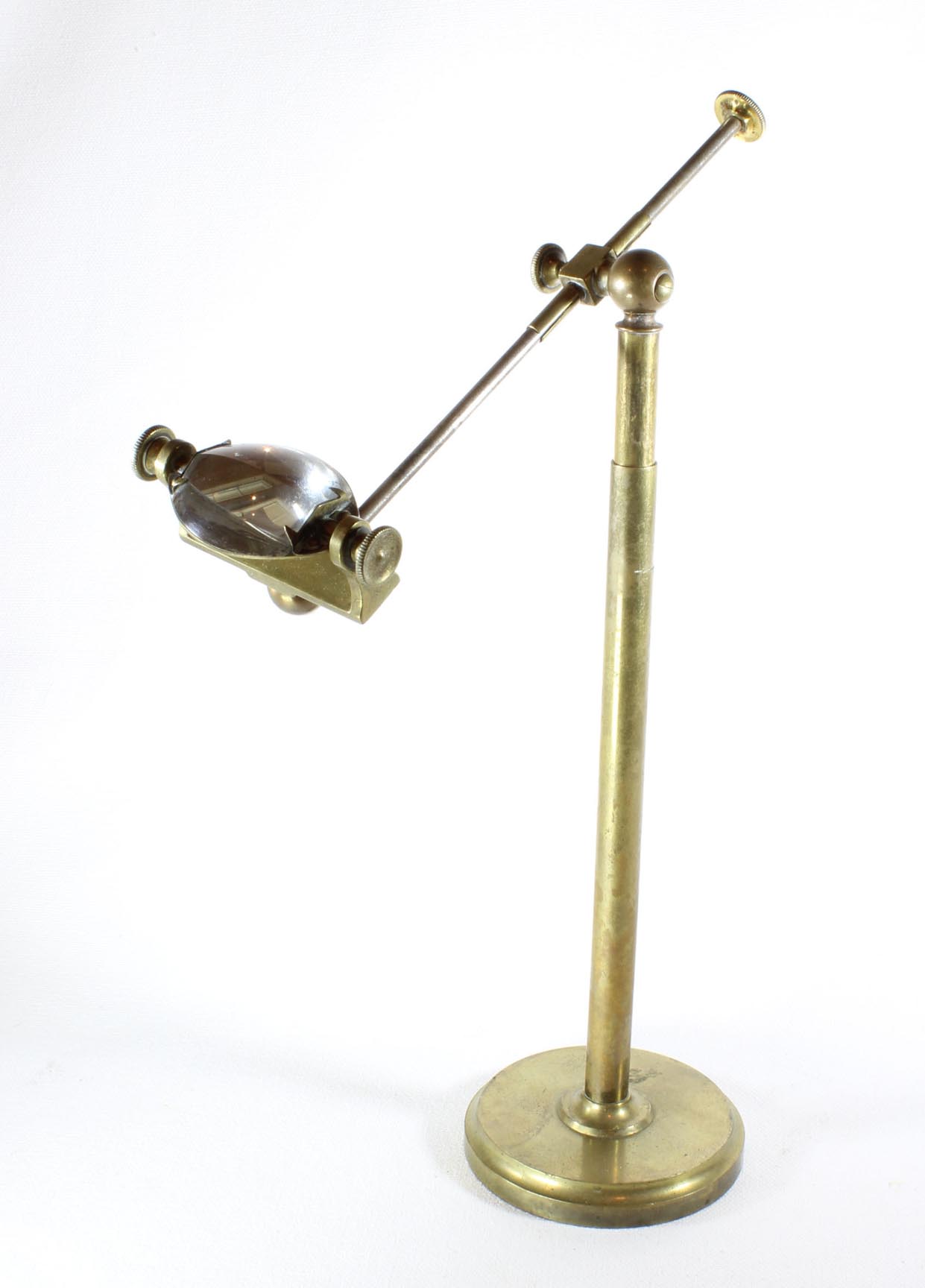
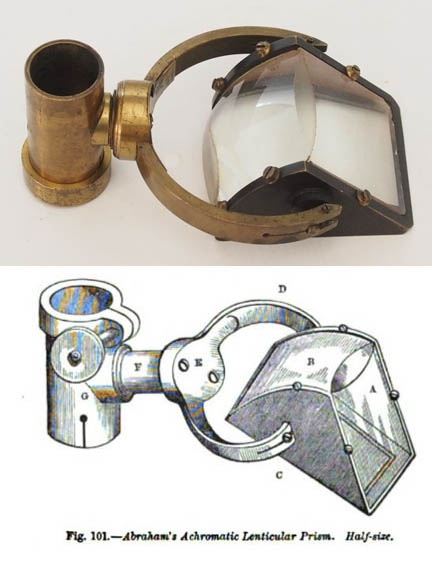
Starting early in the 19th century, one way of producing oblique illumination was to use a lenticular
prism as invented by Amici and shown to the left. This modification of a prism had curved surfaces to allow the light to be concentrated. Amici's form was not achromatic however. An improvement on Amici's prism was an achromatic form devised by Abraham(right). In this prism a double convex lens of crown glass (B) is fitted to a prism of flint glass(A) that is ground to receive it. This type of prism was much more expensive to produce and for this reason, never became as popular as the Amici version.
THE SWINGING SUBSTAGE:
The concave mirror, OR a lenticular prism illuminator, illuminating the subject from an angle outside the optical axis will provide oblique illumination, limited by the thickness of the stage and the degree of rotation out of the optical axis of the mount for it. This axis of rotation was often incorporated into a swinging substage
one of the earliest being by Thomas Grubb in 1853-4, who used a lenticular prism mounted in the swinging substage.
Later versions of the swinging substage, initially usually just swinging a mirror, but later often swinging a condenser and a mirror, became very popular in both England and the U.S.A., especially in the 1860s to 1890s; during that time, ever more complex and sophisticated methods of providing greater and greater degrees of obliquity were devised culminating in such contraptions as the Ross Radial
microscope.
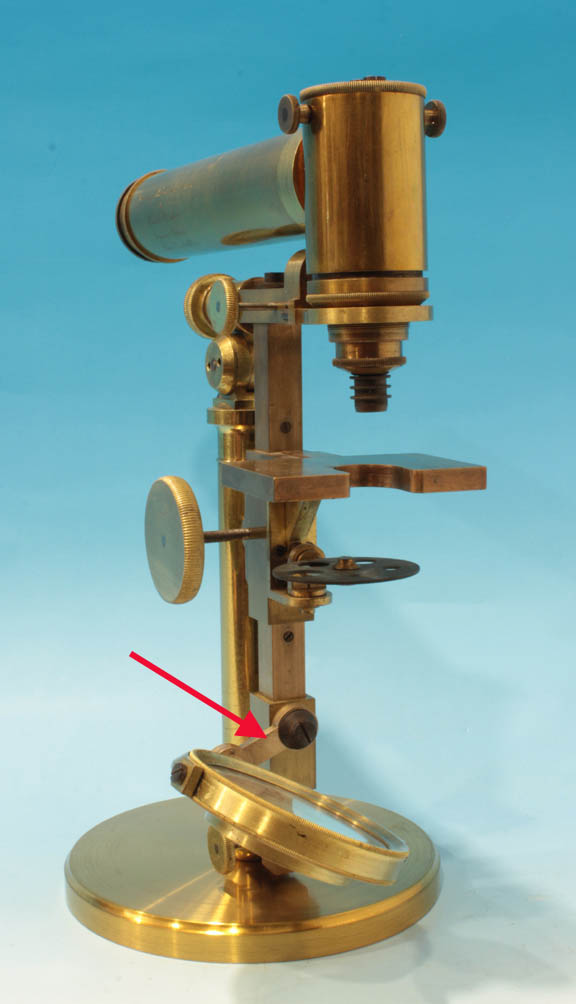
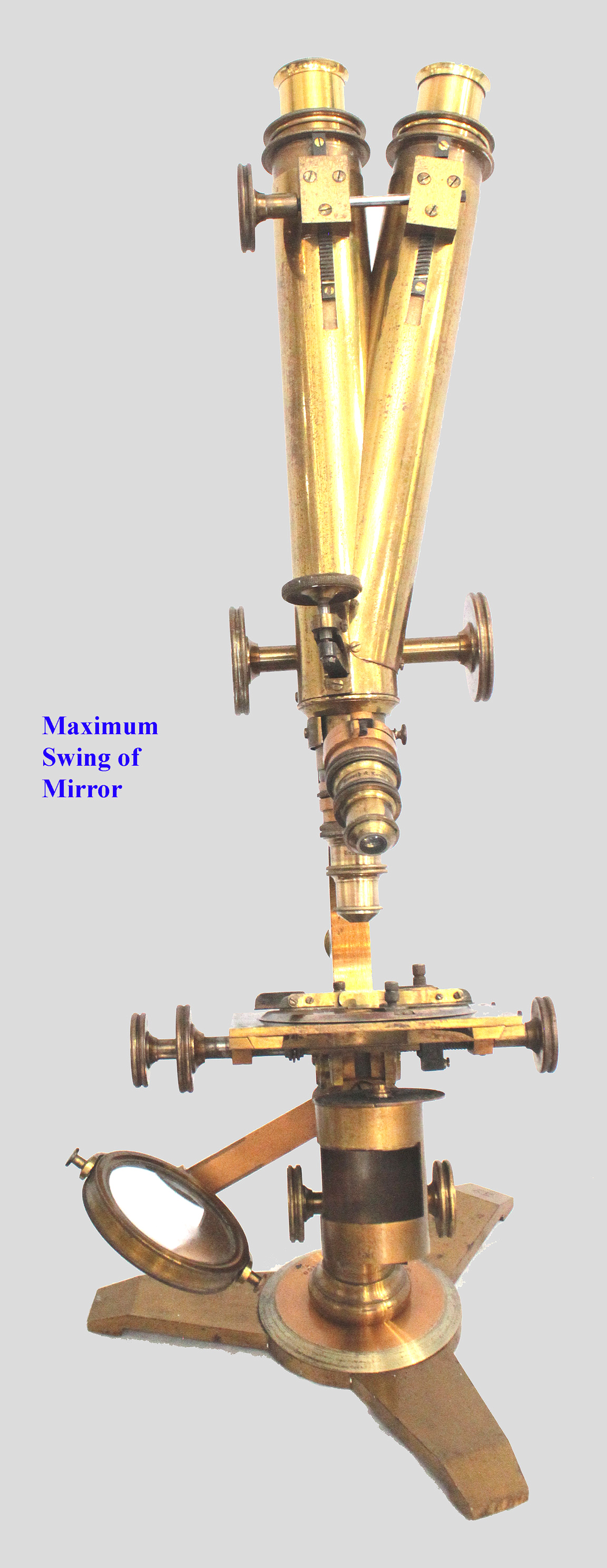
Perhaps the first facility to allow oblique illumination was displacing a concave mirror from the optical axis. The swinging tailpiece to which the mirror was attached was one of the earliest built-in methods to accomplish this and many microscopes of the 19th century had this facility. Shown to the left is the Universal Achromatic Microscope
of Chevalier of about 1840 which has a plane and concave mirror. The microscope has a short swinging arm to allow oblique illlumination when used with the concave mirror. An example of an American Microscope by Walter Bulloch, with a swinging tailpiece below the stage is shown to the right; note that the axis of rotation of both of these is below the level of the subject being studied.
As time went on, the swinging arms became longer and, along with thinner stages, allowed more oblique lighting. On some of the more complex models, the swinging arm might have 2 or more hinged articulating pieces. Te use of a concave mirror alone, though providing oblique illumination, was insufficient with high power. For this, two alternative methods were used. One was to allow the condenser to also swing, so it could be used with the mirror to project concentrated oblique lighting at higher powers. Another was the use of dedicated substage oblique illuminators of which several variations by different inventors were produced. Both of these methods allowed extremely oblique lighting even with higher magnification.
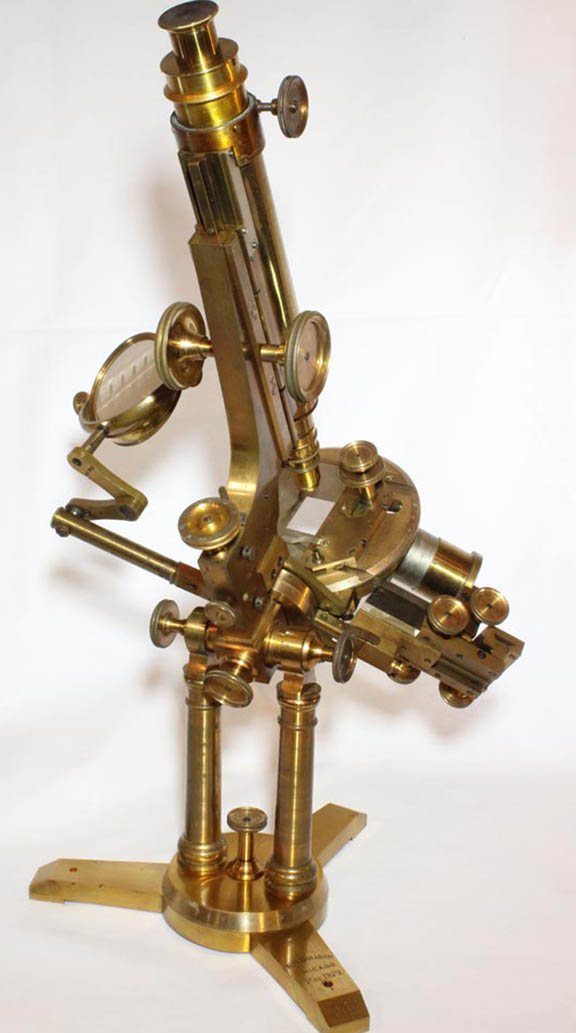
An improvement on the swinging arm substage was invented by Zentmayer who, instead of making the axis of rotation of the tailpiece beneath the stage, made the axis of rotation concentric with the top of the stage where the subject being studied would be. This meant that the distance (focus) of the substage from the subject being observed would not need to change with each change in objective focal length. This type of substage was also made by Bulloch, but he decided to have two swinging substages one for the condenser and one for the mirror. An example of the double swinging substage form by Bulloch is seen to the left. The obvious advantage of this was simply the ability to swing the mirror and use it alone while the condenser was swung out of the way, which was satisfactory for oblique illumination with low magnifications. Whether there is any other advantage in this double-swinging substage is questionable; the only other maker who copied the double swinging substage that I am aware of was Bausch & Lomb as found on their Professional model. Perhaps the most complex method of adjusting the type of oblique substage illumination was the Wenham-Ross Radial Model. As dicussed in the introduction, as the angular aperture of condensers increased, and especially as oil immersion condensers became available, the swinging substage abruptly became obsolete.
OBLIQUE ILLUMINATORS:
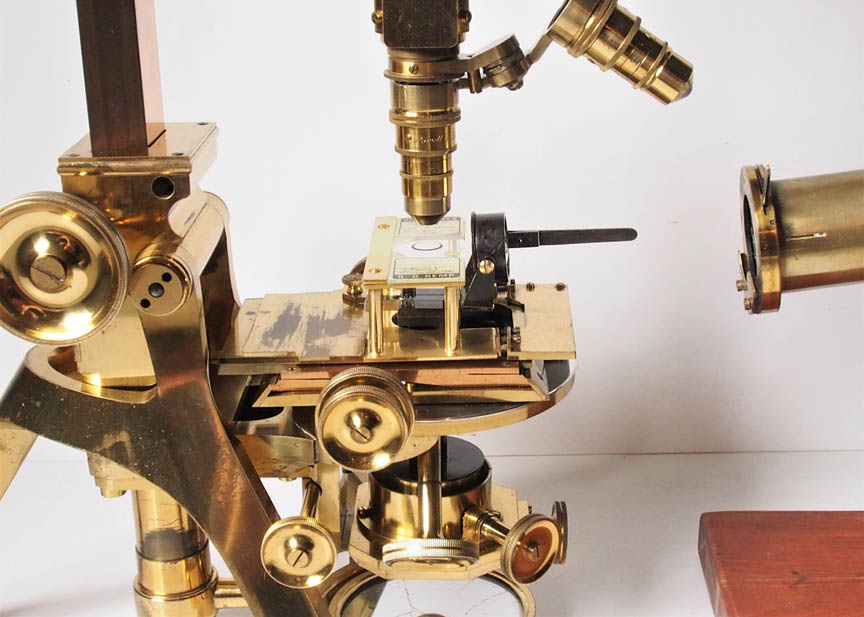 Many models of dedicated substage oblique illuminators were developed over the years. These included those that fit into the substage like an ordinary condenser, and some that stuck to the bottom of the slide using glycerin (and later oil). Condenser-like illuminators were also often oiled to the bottom of the slide as well. One type of highly effective, but difficult to use, oblique illuminator sold by Powell & Lealand(left), installed on the substage ring, protruded through the stage opening and directed the light beam horizontally onto the front side of the slide which was sitting on an elevated accessory stage, providing the most extreme degree of oblique lighting. Other methods were also devised and discussed below.
Many models of dedicated substage oblique illuminators were developed over the years. These included those that fit into the substage like an ordinary condenser, and some that stuck to the bottom of the slide using glycerin (and later oil). Condenser-like illuminators were also often oiled to the bottom of the slide as well. One type of highly effective, but difficult to use, oblique illuminator sold by Powell & Lealand(left), installed on the substage ring, protruded through the stage opening and directed the light beam horizontally onto the front side of the slide which was sitting on an elevated accessory stage, providing the most extreme degree of oblique lighting. Other methods were also devised and discussed below.
One of the earliest substage illuminators to be used for oblique illumination was that of Kingsley, before 1850. The most interesting thing about that illuminator is that it was like an ordinary condenser with a wheel of apertures, but in use the slide was positioned off axis to achieve the desired effect. A similar method, moving the condenser off axis instead of the slide was a facility provided much later, but was much more popular(see below).
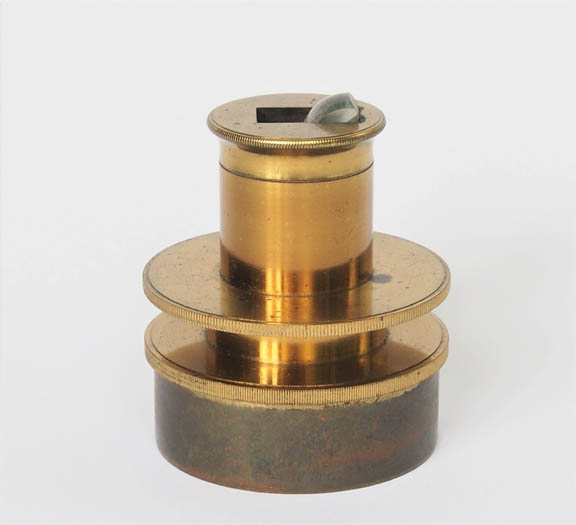
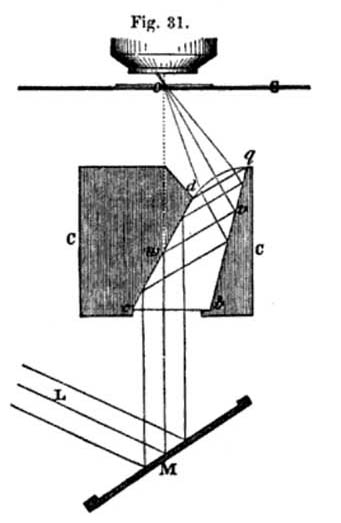 By 1850, as described by Shadboldt in the Transactions of the Microscopical Society of that year, volume 3, page 74, Nachet had devised his prism illuminator and this design was copied by the English manufacturers, an example by Beck shown here to the left, and diagramatically to the right. The English version is an improvement over the original in that it is housed in a rotating housing allowing the illumination direction to be changed more easily.
By 1850, as described by Shadboldt in the Transactions of the Microscopical Society of that year, volume 3, page 74, Nachet had devised his prism illuminator and this design was copied by the English manufacturers, an example by Beck shown here to the left, and diagramatically to the right. The English version is an improvement over the original in that it is housed in a rotating housing allowing the illumination direction to be changed more easily.
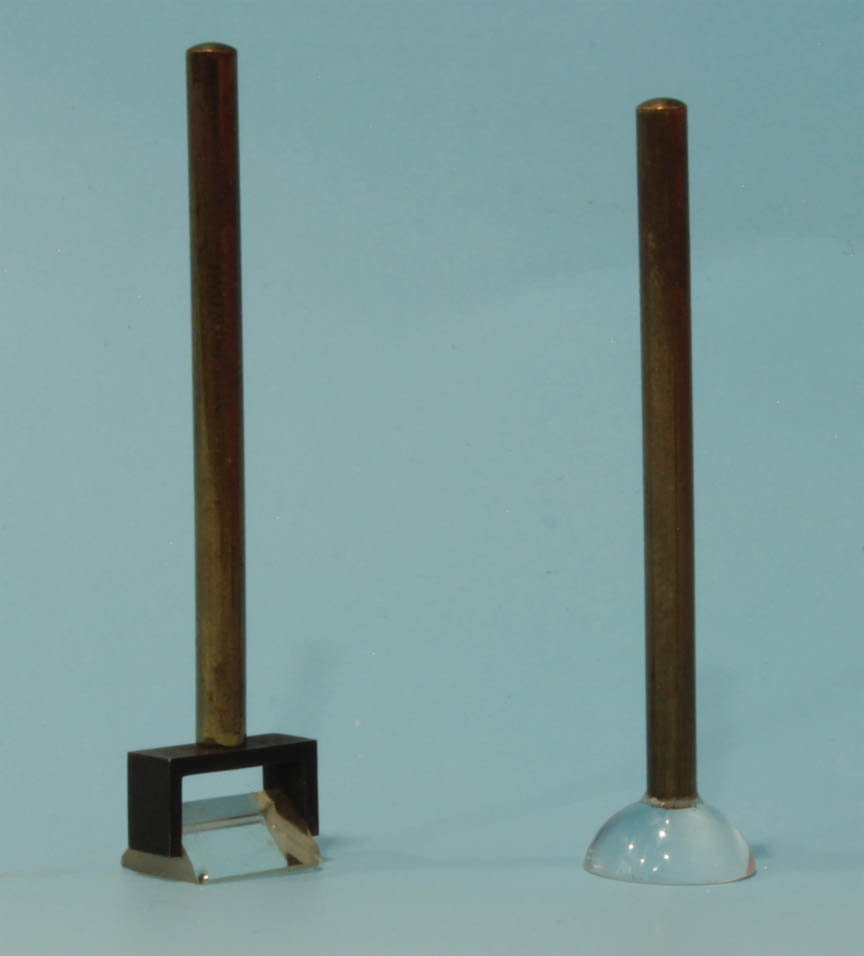

A simple method of achieving oblique illumination was to use a small planoconvex lens oiled to the bottom of the slide. This device, invented by Francis Wenham around 1860, was available mounted on a brass rod to fit inside a darkwell holder, but could simply be oiled to the slide without this support; the latter arrangement was widely held to be superior. Another form used in the same way was a small equilateral prism; examples of both are shown to the left. Wenham improved the design to use a thin half cylinder with rounded edge, reported in an article in the English Mechanic and World of Science in 1879, and shown diagramatically to the right.
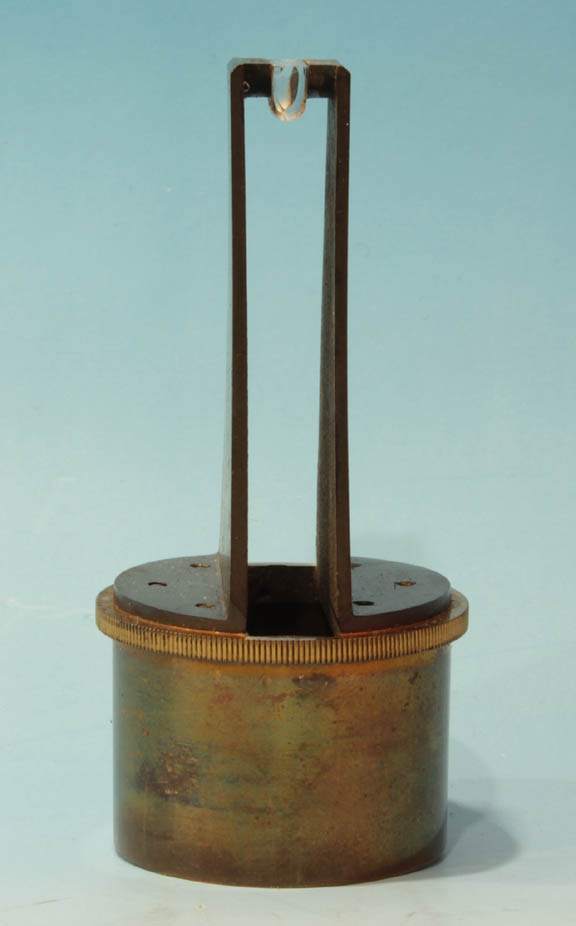
A similar device, shown to the left, is a hemicylinder mounted between two support fins. This substage holder, supporting Wenham's half cylinder, was devised by Mayall.
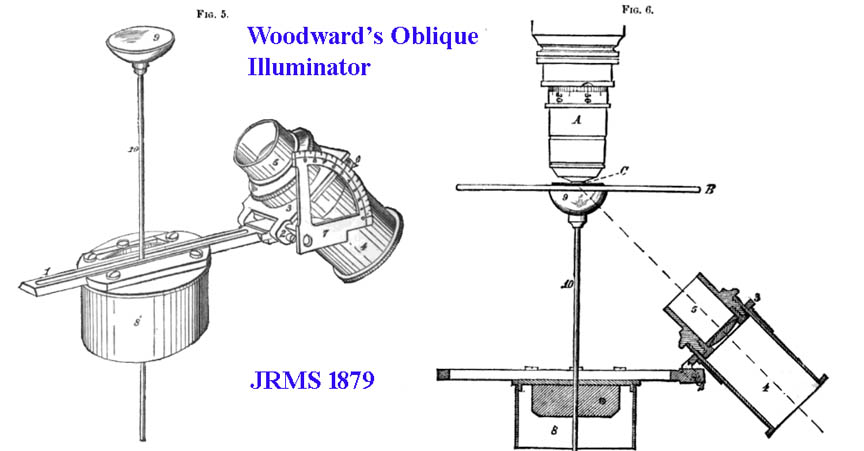
In 1879, Woodward reported a form of Wenham's oblique illuminator supporting the lens on a rod with the addition of an attached dedicated beam-directing lens in a tube which registered the angle of illumination on an attached scale.
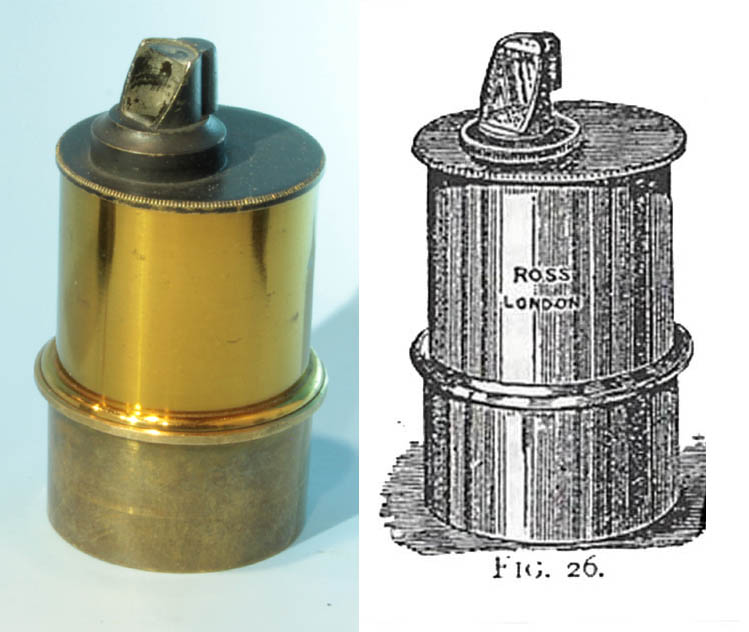
WENHAMS REFLEX ILLUMINATOR
was shown in the Ross 1883 catalog and noted in the JRMS in 1883. It provides dark ground illumination for higher powers. It requires immersion to the bottom of the slide, and accurate centering of the indicating dot on top of the support for the optics. The higher the refractive index of the immersion solution, the higher power and n.a. objective that can be used with it. This condenser was provided especially by Ross.
UNDER-CONDENSER WHEELS AND INSERTS and for OBLIQUE ILLUMINATION:
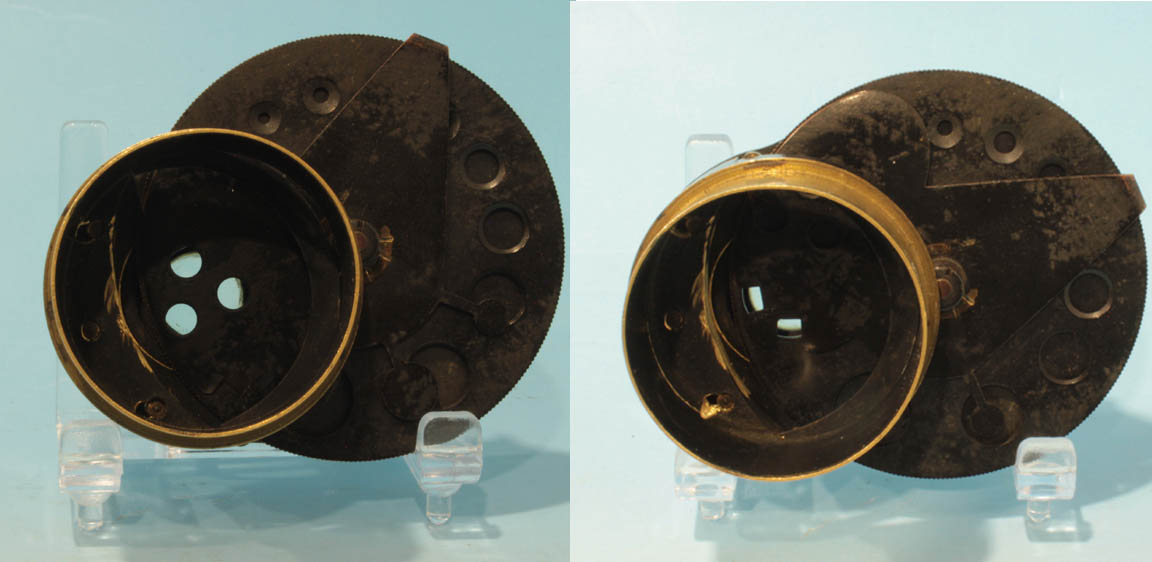 Among the first provisions of a wheel of apertures that had features allowing oblique illumination was the
Among the first provisions of a wheel of apertures that had features allowing oblique illumination was the High Power Achromatic Condenser
introduced in 1857 by Powell & Lealand. As shown to the left, it had an oblique illumination stop with illumination via rectangular openings from two sides, and another from three round openings. Condensers supplied with higher class microscopes were usually supplied with oblique illumination inserts starting in the 1870s and continued into the 20th century.
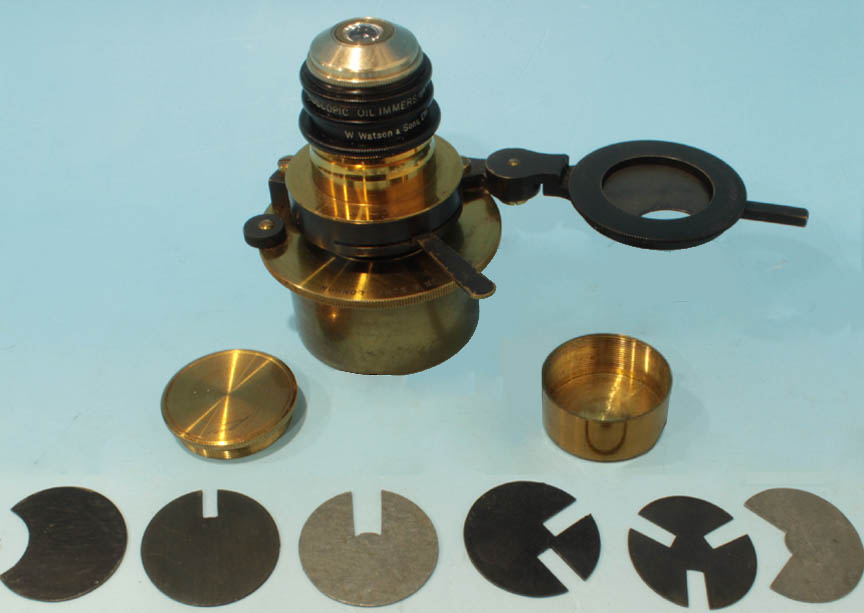 Although slip-in central stops for dark ground illumination and wheels of these stops were supplied earlier, under-the-condenser provisions for oblique illumination were not commonly provided with microscopes until the 2nd half of the 19th century. Once condensers with a swing-out ring on their bottom were common, these oblique inserts, which fit into these rings(which also accepted darkfield stops), were often part of the standard equipment supplied with such condensers. This type of oblique illumination is limited at high powers as some of the other methods noted above because the light bearm is not projected at a marked angle, and it severely reduces the amount of light reaching the subject being studied. This is obviated to an extent, though with high angular aperture condensers, especially with oil immersion condensers. Nevertheless, because of the relatively low additional cost, these stops were a common microscope accessory for many years and are effective at lower powers. These stops, a selection of which are shown to the right, were supplied with the condenser housing shown. That housing is the type sold by Watson and also by Swift, though not neccesarily of the same size. It should be noted that the receptacles for these stops, or inserts, varied between condensers, even by the same manufacturer and even the same model of condenser, since the same model was sometimes made in different diameters to fit different substages. For example, Watson inserts from about 1900 were typically 21.35 mm or 34.75 mm in diameter, depending on which condenser housing they were being used with. The Swift Universal Condensers came in different diameters and one in my collection takes inserts of 24.3 mm, while a later one of larger diameter takes 27.2 mm inserts. The Bausch & Lomb condenser on my Tolles A-stand takes 31mm inserts as does a Hartnack Microscope condenser from about 1880. The achromatic condenser for a Wild M-20 from the third quarter of the 20th century uses 33 mm inserts.
Although slip-in central stops for dark ground illumination and wheels of these stops were supplied earlier, under-the-condenser provisions for oblique illumination were not commonly provided with microscopes until the 2nd half of the 19th century. Once condensers with a swing-out ring on their bottom were common, these oblique inserts, which fit into these rings(which also accepted darkfield stops), were often part of the standard equipment supplied with such condensers. This type of oblique illumination is limited at high powers as some of the other methods noted above because the light bearm is not projected at a marked angle, and it severely reduces the amount of light reaching the subject being studied. This is obviated to an extent, though with high angular aperture condensers, especially with oil immersion condensers. Nevertheless, because of the relatively low additional cost, these stops were a common microscope accessory for many years and are effective at lower powers. These stops, a selection of which are shown to the right, were supplied with the condenser housing shown. That housing is the type sold by Watson and also by Swift, though not neccesarily of the same size. It should be noted that the receptacles for these stops, or inserts, varied between condensers, even by the same manufacturer and even the same model of condenser, since the same model was sometimes made in different diameters to fit different substages. For example, Watson inserts from about 1900 were typically 21.35 mm or 34.75 mm in diameter, depending on which condenser housing they were being used with. The Swift Universal Condensers came in different diameters and one in my collection takes inserts of 24.3 mm, while a later one of larger diameter takes 27.2 mm inserts. The Bausch & Lomb condenser on my Tolles A-stand takes 31mm inserts as does a Hartnack Microscope condenser from about 1880. The achromatic condenser for a Wild M-20 from the third quarter of the 20th century uses 33 mm inserts.
AXIAL DISPLACEMENT OF THE LIGHT ENTERING THE SUBSTAGE CONDENSER:
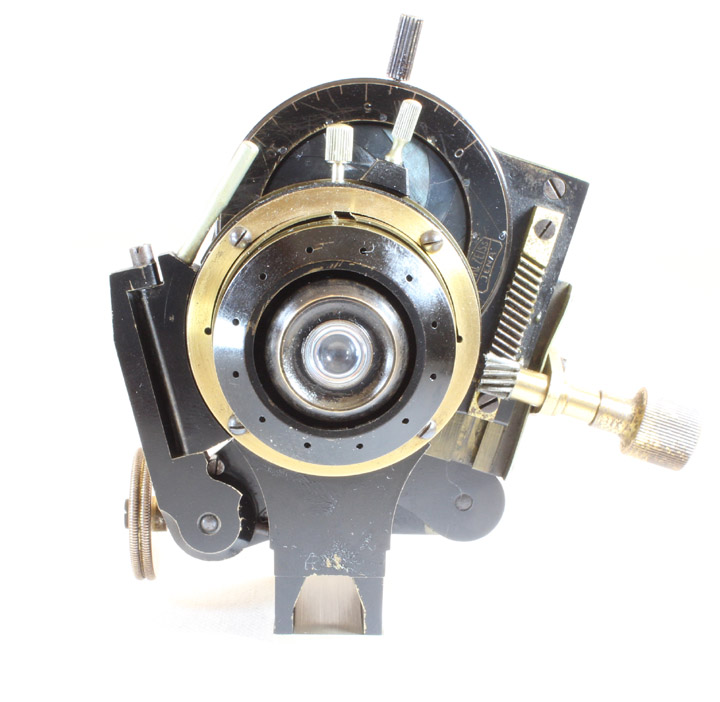 Another method of providing oblique illumination is by simply having a facility for moving the bottom aperture of the condenser, or its holder, out of the center of the optical axis, and simultaneously reducing the diameter of the light beam with a diaphragm. The most common way to do this was to have an iris diaphragm on the bottom of the condenser that could be moved off axis by rack and pinion. In addition, these condenser housings usually could be rotated, so the illumination could be directed from any horizontal position. This arrangement was frequently supplied by the German makers Zeiss and Leitz in the early 20th century and became commonly supplied by other makers thereafter.
Another method of providing oblique illumination is by simply having a facility for moving the bottom aperture of the condenser, or its holder, out of the center of the optical axis, and simultaneously reducing the diameter of the light beam with a diaphragm. The most common way to do this was to have an iris diaphragm on the bottom of the condenser that could be moved off axis by rack and pinion. In addition, these condenser housings usually could be rotated, so the illumination could be directed from any horizontal position. This arrangement was frequently supplied by the German makers Zeiss and Leitz in the early 20th century and became commonly supplied by other makers thereafter.
LATER DEVELOPMENTS:
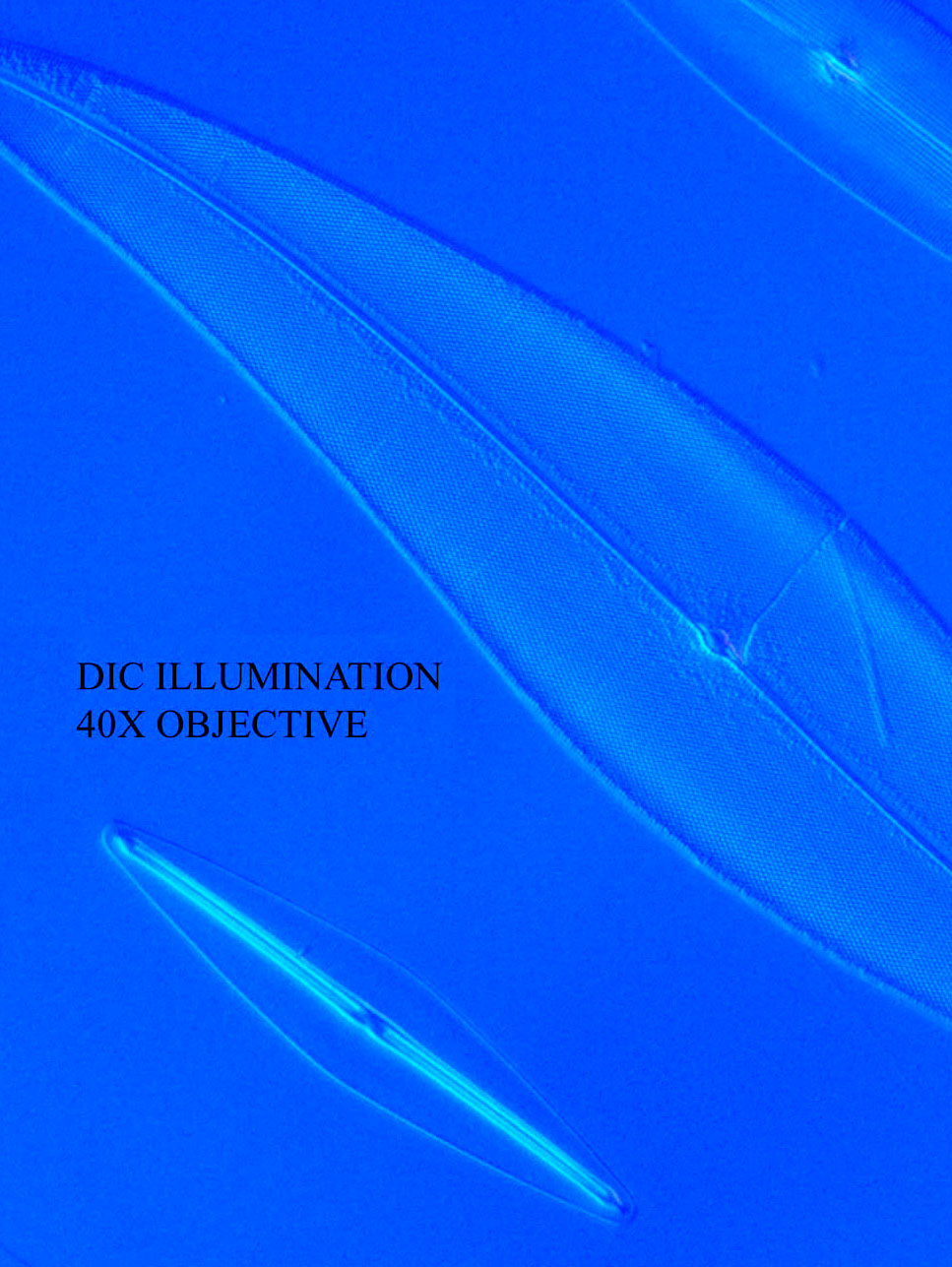 Many objects that were formerly best seen with oblique illumination are now visualized with other techniques like oil immersion, phase contrast or DIC (Differential Interference Contrast). Nevertheless, properly set up oblique illumination is still very effective for visualizing periodic structures like the periodic structures in diatoms.
Many objects that were formerly best seen with oblique illumination are now visualized with other techniques like oil immersion, phase contrast or DIC (Differential Interference Contrast). Nevertheless, properly set up oblique illumination is still very effective for visualizing periodic structures like the periodic structures in diatoms.

 Among the first to report on a substage method of oblique illumination was the Rev. J. B. Reade of Cambridge as reported in the appendix of the book Micrographia authored by Pritchard and Goring in 1837. This is next mentioned in John Quekett's Practical Treatise on the Use of the Microscope of 1848, pages 178-9. As time went on, various devices were developed to improve the ease, precision, and degree of oblique lighting. Three ways to improve oblique lighting were commonly used in the 3rd quarter of the 19th century, and later. These included the use of the Amici Lenticular Prism Illuminator, the Swinging Substage, the use of under-condenser Oblique Inserts (
Among the first to report on a substage method of oblique illumination was the Rev. J. B. Reade of Cambridge as reported in the appendix of the book Micrographia authored by Pritchard and Goring in 1837. This is next mentioned in John Quekett's Practical Treatise on the Use of the Microscope of 1848, pages 178-9. As time went on, various devices were developed to improve the ease, precision, and degree of oblique lighting. Three ways to improve oblique lighting were commonly used in the 3rd quarter of the 19th century, and later. These included the use of the Amici Lenticular Prism Illuminator, the Swinging Substage, the use of under-condenser Oblique Inserts (




 Many models of dedicated substage oblique illuminators were developed over the years. These included those that fit into the substage like an ordinary condenser, and some that stuck to the bottom of the slide using glycerin (and later oil). Condenser-like illuminators were also often oiled to the bottom of the slide as well. One type of highly effective, but difficult to use, oblique illuminator sold by Powell & Lealand(left), installed on the substage ring, protruded through the stage opening and directed the light beam horizontally onto the front side of the slide which was sitting on an elevated accessory stage, providing the most extreme degree of oblique lighting. Other methods were also devised and discussed below.
Many models of dedicated substage oblique illuminators were developed over the years. These included those that fit into the substage like an ordinary condenser, and some that stuck to the bottom of the slide using glycerin (and later oil). Condenser-like illuminators were also often oiled to the bottom of the slide as well. One type of highly effective, but difficult to use, oblique illuminator sold by Powell & Lealand(left), installed on the substage ring, protruded through the stage opening and directed the light beam horizontally onto the front side of the slide which was sitting on an elevated accessory stage, providing the most extreme degree of oblique lighting. Other methods were also devised and discussed below.
 By 1850, as described by Shadboldt in the Transactions of the Microscopical Society of that year, volume 3, page 74, Nachet had devised his prism illuminator and this design was copied by the English manufacturers, an example by Beck shown here to the left, and diagramatically to the right. The English version is an improvement over the original in that it is housed in a rotating housing allowing the illumination direction to be changed more easily.
By 1850, as described by Shadboldt in the Transactions of the Microscopical Society of that year, volume 3, page 74, Nachet had devised his prism illuminator and this design was copied by the English manufacturers, an example by Beck shown here to the left, and diagramatically to the right. The English version is an improvement over the original in that it is housed in a rotating housing allowing the illumination direction to be changed more easily.




 Among the first provisions of a wheel of apertures that had features allowing oblique illumination was the
Among the first provisions of a wheel of apertures that had features allowing oblique illumination was the  Although slip-in central stops for dark ground illumination and wheels of these stops were supplied earlier, under-the-condenser provisions for oblique illumination were not commonly provided with microscopes until the 2nd half of the 19th century. Once condensers with a swing-out ring on their bottom were common, these oblique inserts, which fit into these rings(which also accepted darkfield stops), were often part of the standard equipment supplied with such condensers. This type of oblique illumination is limited at high powers as some of the other methods noted above because the light bearm is not projected at a marked angle, and it severely reduces the amount of light reaching the subject being studied. This is obviated to an extent, though with high angular aperture condensers, especially with oil immersion condensers. Nevertheless, because of the relatively low additional cost, these stops were a common microscope accessory for many years and are effective at lower powers. These stops, a selection of which are shown to the right, were supplied with the condenser housing shown. That housing is the type sold by Watson and also by Swift, though not neccesarily of the same size. It should be noted that the receptacles for these stops, or inserts, varied between condensers, even by the same manufacturer and even the same model of condenser, since the same model was sometimes made in different diameters to fit different substages. For example, Watson inserts from about 1900 were typically 21.35 mm or 34.75 mm in diameter, depending on which condenser housing they were being used with. The Swift Universal Condensers came in different diameters and one in my collection takes inserts of 24.3 mm, while a later one of larger diameter takes 27.2 mm inserts. The Bausch & Lomb condenser on my Tolles A-stand takes 31mm inserts as does a Hartnack Microscope condenser from about 1880. The achromatic condenser for a Wild M-20 from the third quarter of the 20th century uses 33 mm inserts.
Although slip-in central stops for dark ground illumination and wheels of these stops were supplied earlier, under-the-condenser provisions for oblique illumination were not commonly provided with microscopes until the 2nd half of the 19th century. Once condensers with a swing-out ring on their bottom were common, these oblique inserts, which fit into these rings(which also accepted darkfield stops), were often part of the standard equipment supplied with such condensers. This type of oblique illumination is limited at high powers as some of the other methods noted above because the light bearm is not projected at a marked angle, and it severely reduces the amount of light reaching the subject being studied. This is obviated to an extent, though with high angular aperture condensers, especially with oil immersion condensers. Nevertheless, because of the relatively low additional cost, these stops were a common microscope accessory for many years and are effective at lower powers. These stops, a selection of which are shown to the right, were supplied with the condenser housing shown. That housing is the type sold by Watson and also by Swift, though not neccesarily of the same size. It should be noted that the receptacles for these stops, or inserts, varied between condensers, even by the same manufacturer and even the same model of condenser, since the same model was sometimes made in different diameters to fit different substages. For example, Watson inserts from about 1900 were typically 21.35 mm or 34.75 mm in diameter, depending on which condenser housing they were being used with. The Swift Universal Condensers came in different diameters and one in my collection takes inserts of 24.3 mm, while a later one of larger diameter takes 27.2 mm inserts. The Bausch & Lomb condenser on my Tolles A-stand takes 31mm inserts as does a Hartnack Microscope condenser from about 1880. The achromatic condenser for a Wild M-20 from the third quarter of the 20th century uses 33 mm inserts.
 Another method of providing oblique illumination is by simply having a facility for moving the bottom aperture of the condenser, or its holder, out of the center of the optical axis, and simultaneously reducing the diameter of the light beam with a diaphragm. The most common way to do this was to have an iris diaphragm on the bottom of the condenser that could be moved off axis by rack and pinion. In addition, these condenser housings usually could be rotated, so the illumination could be directed from any horizontal position. This arrangement was frequently supplied by the German makers Zeiss and Leitz in the early 20th century and became commonly supplied by other makers thereafter.
Another method of providing oblique illumination is by simply having a facility for moving the bottom aperture of the condenser, or its holder, out of the center of the optical axis, and simultaneously reducing the diameter of the light beam with a diaphragm. The most common way to do this was to have an iris diaphragm on the bottom of the condenser that could be moved off axis by rack and pinion. In addition, these condenser housings usually could be rotated, so the illumination could be directed from any horizontal position. This arrangement was frequently supplied by the German makers Zeiss and Leitz in the early 20th century and became commonly supplied by other makers thereafter.  Many objects that were formerly best seen with oblique illumination are now visualized with other techniques like oil immersion, phase contrast or DIC (Differential Interference Contrast). Nevertheless, properly set up oblique illumination is still very effective for visualizing periodic structures like the periodic structures in diatoms.
Many objects that were formerly best seen with oblique illumination are now visualized with other techniques like oil immersion, phase contrast or DIC (Differential Interference Contrast). Nevertheless, properly set up oblique illumination is still very effective for visualizing periodic structures like the periodic structures in diatoms.